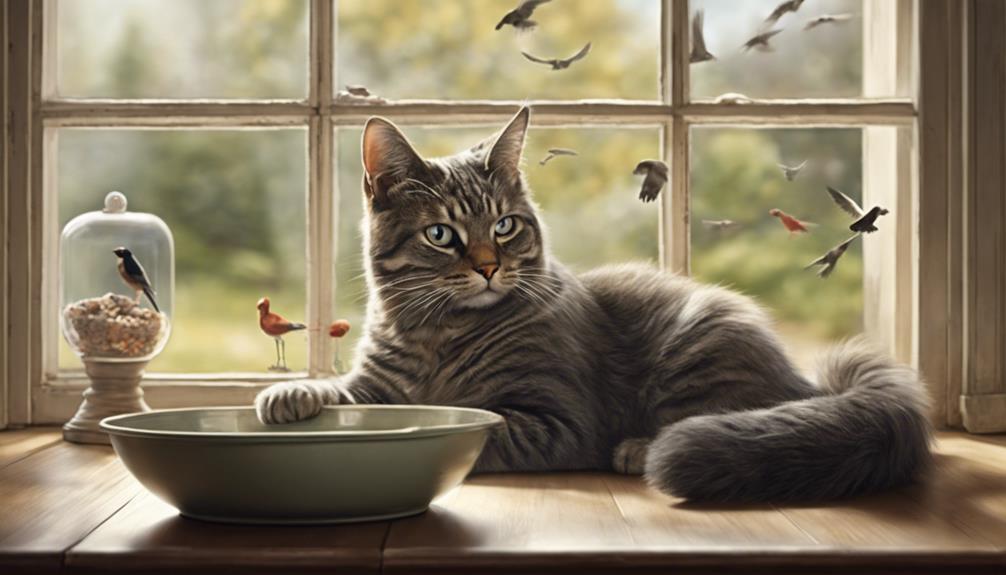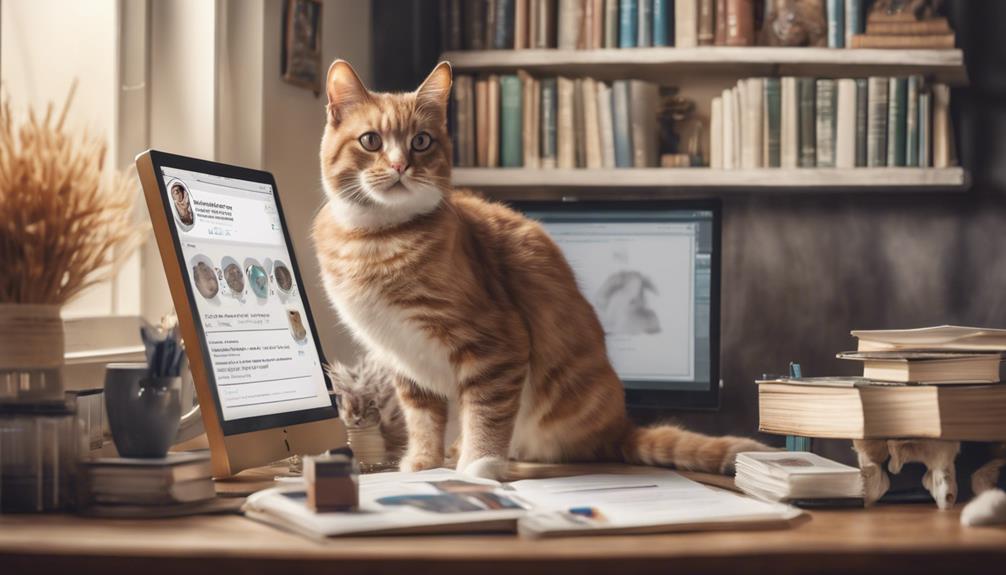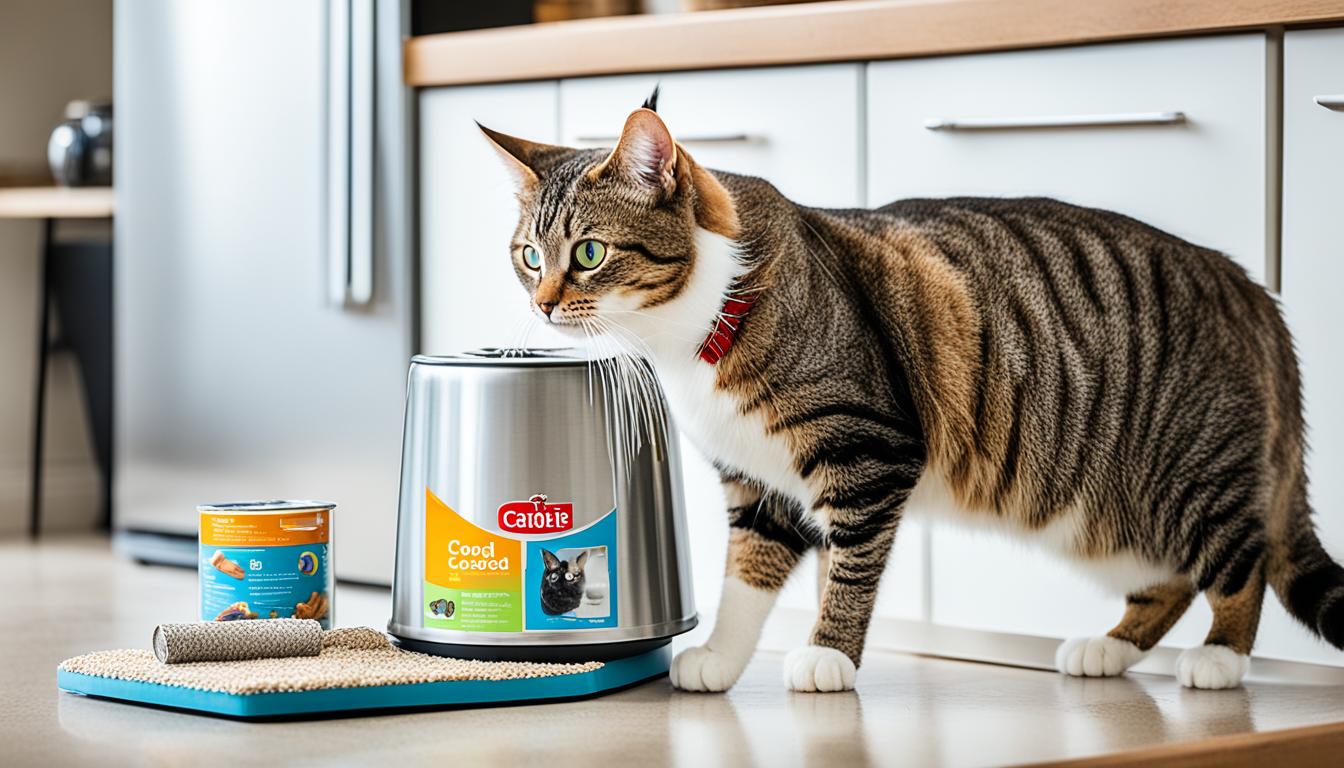Cats can get bored. Signs like excessive grooming, meowing more, or ignoring toys may indicate boredom. Providing mental and physical stimulation, interactive toys, and playtime can help combat it. Observation is key to spotting boredom-related changes. Lack of activity, restricted space, and ignored instincts can trigger boredom. Stress relief through play and a stimulating environment are vital. Preventive measures like varied toys, play routines, and social interaction can keep cats engaged. Remember, understanding boredom cues is essential for your feline's well-being.
Key Takeaways
- Cats do get bored, leading to behavioral issues.
- Signs of cat boredom include excessive grooming and disinterest in toys.
- To prevent boredom, provide mental stimulation and interactive play.
- Boredom can impact a cat's health, leading to stress and obesity.
- Enriching the environment with toys and activities helps combat boredom.
Signs of Cat Boredom
Do cats exhibit specific signs when they're feeling bored? Absolutely! Cats can be quite expressive when they're feeling unstimulated. Excessive grooming, destructive behavior like scratching furniture, and increased vocalization are common signs of cat boredom. You might notice your feline friend showing disinterest in toys they usually enjoy or sleeping more than usual. These behaviors are their way of telling us that they need more mental and physical stimulation.
Moreover, factors such as a lack of playtime, social interaction, and vertical space can contribute to cat boredom. It's crucial to ponder medical issues as well, as they could be causing your cat's boredom. By being attentive to these signs and addressing the root cause, you can help alleviate your cat's boredom.
Understanding Cat Boredom
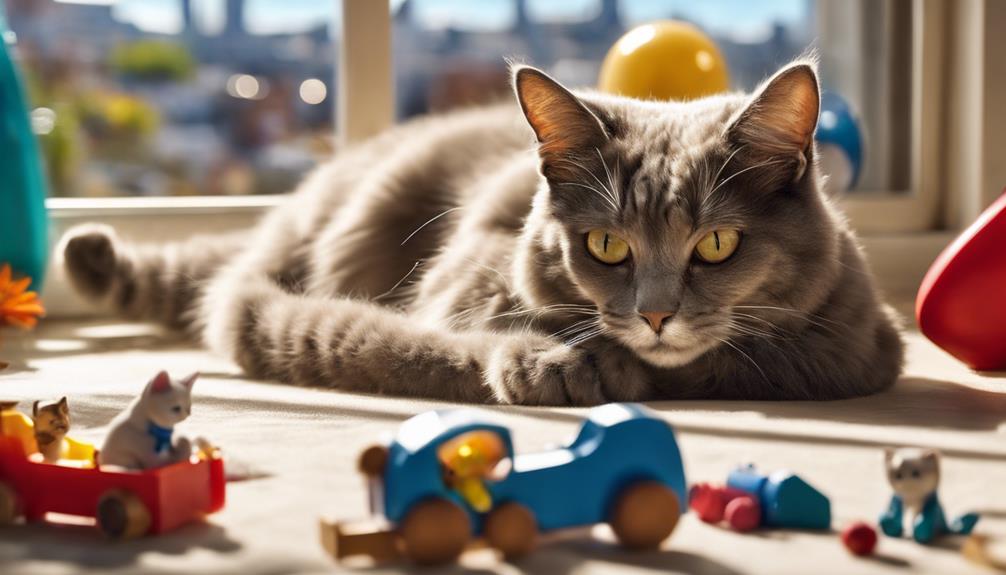
Cat boredom is a real issue that can affect our feline friends when they lack mental and physical stimulation. Signs of boredom in cats can range from restlessness to aggression towards other pets.
To combat cat boredom, providing toys, interactive games, and opportunities for indoor foraging experiences can keep our cats engaged and content.
Signs of Cat Boredom
Recognizing the signs of boredom in cats is essential for ensuring their overall well-being and happiness. Cats may exhibit signs such as excessive grooming, lack of interest in toys, lack of vertical space, and a decrease in their usual playful behavior. Below is a table summarizing common signs of cat boredom:
| Signs of Cat Boredom | Description |
|---|---|
| Excessive grooming | Cats may over-groom themselves, leading to skin irritation. |
| Lack of interest in toys | Cats show disinterest in their usual toys or playthings. |
| Lack of vertical space | Cats may seek higher spaces if they feel confined. |
| Interactive toys | Cats benefit from toys that engage their minds and bodies. |
Understanding these signs can help address your cat's boredom and improve their quality of life.
Combatting Cat Boredom
Understanding the underlying causes of cat boredom is essential in combatting this issue and promoting a happier feline companion. To keep your cat mentally stimulated, provide a variety of engaging toys and interactive games. Spending quality time engaging in play sessions and showing affection can also alleviate boredom-related behaviors.
Creating indoor foraging experiences by hiding treats around the house is another effective way to prevent boredom. By keeping your cat mentally and physically stimulated through these activities, you can help prevent boredom and promote their overall well-being. Remember, a happy and entertained cat isn't only a joy to be around but also likely to exhibit fewer destructive behaviors associated with boredom.
Behavioral Indicators of Cat Boredom
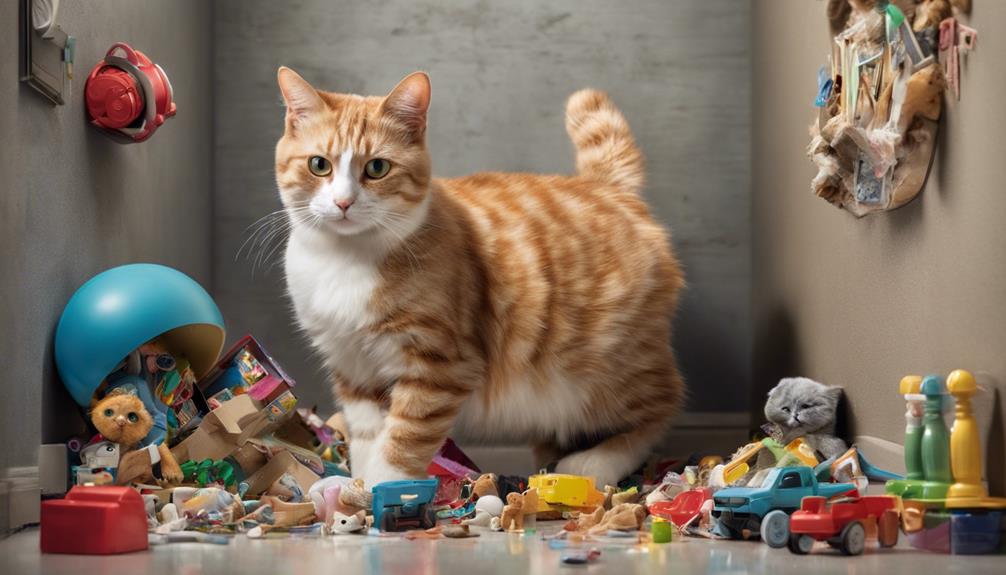
Identifying behavioral indicators of cat boredom can help pet owners address their feline companions' mental and physical well-being effectively. When our cats lack mental stimulation, they may exhibit signs of boredom such as excessive grooming, destructive behavior, or increased vocalization. Keep an eye out for a disinterest in interactive toys and an increase in sleeping hours; these could be subtle indicators that your cat needs more engagement.
To combat boredom, consider providing a range of interactive toys that challenge their minds and encourage physical activity. Additionally, creating an enriched environment with spaces to climb, hide, and explore can greatly benefit their well-being. Remember, insufficient playtime, limited social interaction, and a lack of vertical space can contribute to your cat's boredom.
Identifying Boredom in Cats

When it comes to cats, recognizing signs of boredom is crucial to their well-being. Excessive grooming, destructive behavior, increased vocalization, and lack of interest in toys are common indicators.
Signs of Cat Boredom
Excessive grooming, destructive behavior, and increased vocalization are clear indicators of cat boredom. Cats may also display disinterest in toys and sleep more than usual when they lack mental and physical stimulation. Insufficient playtime, lack of social interaction, and underlying health problems can contribute to your feline friend feeling bored. To help keep your cat engaged and content, it's crucial to observe these signs of cat boredom and take action. Below is a table summarizing common signs of cat boredom:
| Signs of Cat Boredom |
|---|
| Excessive Grooming |
| Destructive Behavior |
| Increased Vocalization |
| Lack of Interest in Toys |
| Excessive Sleeping |
Preventing Cat Boredom
To prevent cat boredom, guaranteeing a stimulating environment and regular interactive play sessions are vital. Cats can exhibit signs of boredom like excessive grooming, destructive behaviors, or lack of interest in toys when not adequately engaged.
Providing interactive toys and participating in regular playtime can help keep your feline friend entertained and mentally stimulated. Creating an enriched environment with scratching posts, climbing structures, and hiding spots can also prevent boredom.
If possible, considering companion cats for social interaction can further alleviate boredom and enhance your cat's well-being. Recognizing and addressing boredom in cats is essential for their happiness and overall quality of life.
Cat Boredom Triggers

Cat boredom can be triggered by a lack of activity and stimulation. Indoor cats, with their limited opportunities for natural behaviors like hunting, are especially prone to mental stagnation. Signs of boredom in cats can manifest through destructive behavior or excessive sleeping. To prevent this, it's essential to understand the triggers that lead to feline boredom. Here are some key factors that can contribute to cat boredom:
| Cat Boredom Triggers | Examples |
|---|---|
| Lack of physical activity | Limited playtime or exercise opportunities |
| Inadequate mental stimulation | Few interactive toys or puzzles |
| Restricted environment exploration | Confinement to a small space or lack of vertical territory |
| Suppressed hunting instincts | Lack of opportunities to chase or 'hunt' toys |
Environmental Factors in Cat Boredom

Cat boredom can often be linked to environmental factors such as lack of vertical spaces, hiding spots, and engaging toys.
Insufficient playtime and limited social interaction can also contribute to a cat feeling bored.
Creating a stimulating indoor environment with interactive toys and establishing a routine can help prevent boredom in our feline friends.
Cat Toys and Enrichment
Engaging cats with interactive toys and enriching their environment with climbing structures and perches can effectively combat boredom by stimulating their natural instincts and providing mental and physical exercise. Interactive toys, such as puzzle feeders and fishing rod toys, tap into their hunting instincts, preventing boredom. Climbing structures, scratching posts, and window perches offer opportunities for physical activity and mental stimulation. To maintain interest, rotating and introducing new toys regularly can keep cats engaged. Here is a helpful table to showcase some essential cat toys and enrichment options:
| Cat Toys | Enrichment |
|---|---|
| Puzzle feeders | Climbing structures |
| Fishing rod toys | Scratching posts |
| Window perches |
Interactive Playtime Routines
Implementing diverse playtime routines incorporating environmental enhancements is crucial for combating cat boredom and promoting mental stimulation. Engaging in interactive play sessions with toys like fishing rod toys and puzzle feeders helps satisfy a cat's natural hunting instincts while providing necessary exercise.
Creating a variety of play options keeps cats entertained and mentally engaged, preventing boredom. Establishing a routine for interactive play allows cats to anticipate and eagerly participate in engaging activities. Additionally, incorporating environmental factors such as climbing structures, window perches, and cat grass enriches a cat's surroundings, contributing to mental and physical stimulation.
Indoor Environment Stimulation
In our homes, creating a stimulating indoor environment plays a crucial role in preventing cat boredom and ensuring our feline companions lead fulfilling lives. Indoor cats, lacking the opportunity to engage their natural instincts, are more prone to boredom. Signs of boredom in cats can manifest as restlessness or excessive grooming.
To combat this, it's important to provide mental stimulation through climbing structures, scratching posts, and interactive toys. Including hiding spots, puzzle feeders, and dedicated playtime can also alleviate boredom-related behaviors in indoor cats. By enriching their indoor environment, we can help our cats stay mentally engaged and content, promoting their overall well-being and happiness.
Cat Boredom and Health Issues
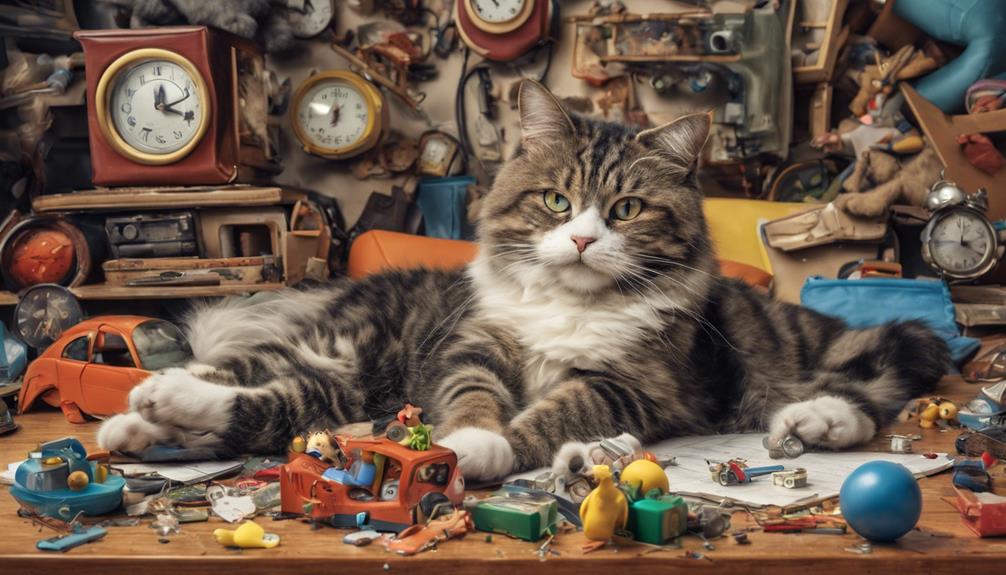
Chronic cat boredom can have detrimental effects on their health, leading to issues such as obesity, stress, and anxiety. When our feline friends lack mental stimulation and engagement in their environment, it can take a toll on their overall well-being. Here are some important points to take into account:
- Boredom can lead to overeating, causing weight gain and related health problems.
- Cats may exhibit signs of stress and anxiety when they aren't mentally stimulated enough.
- Chronic boredom can affect both the mental and physical health of our cats.
- Preventing boredom is key to ensuring our cats stay healthy and happy.
- By addressing their boredom, we can help prevent behavioral issues and enhance their quality of life.
Taking steps to keep our cats mentally engaged and entertained is essential for their health and happiness.
Remedies for Cat Boredom

To combat cat boredom effectively, we can incorporate interactive toys and engage in regular playtime sessions to stimulate our feline friends' minds and prevent boredom-related behaviors. Interactive toys, such as puzzle feeders, provide mental stimulation while satisfying their hunting instincts. These toys challenge their problem-solving skills, keeping their minds sharp and engaged. Regular playtime sessions are essential for bonding and physical activity. Cats love chasing toys like feather wands or laser pointers, keeping them active and entertained.
Creating an enriched environment is key. Offer climbing structures, scratching posts, and hiding spots to encourage exploration and play. Cats enjoy high perches to observe their surroundings and cozy spots for napping. Establishing a consistent routine for feeding, play, and interaction helps provide stability and predictability, reducing stress and boredom.
Consider introducing companion cats for social interaction. Having a feline friend can prevent loneliness and offer opportunities for play and companionship. By incorporating these strategies, we can guarantee our cats lead happy, active lives in a stimulating environment.
Interactive Toy Solutions

Interactive toy solutions are a great way to keep your cat entertained and mentally sharp. Mixing up the types of toys, such as fishing rod toys and puzzle feeders, can engage your cat's hunting instincts and provide both mental and physical stimulation.
Regularly rotating toys and engaging in interactive play sessions can help strengthen the bond between you and your feline friend while preventing boredom.
Toy Variety Options
When considering ways to alleviate boredom in cats, exploring toy variety options like fishing rod toys, kicker toys, and puzzle feeders can be highly effective. Cats benefit from a diverse range of interactive toys that provide mental stimulation and entertainment. Here are some toy variety options to keep your feline friend engaged:
- Ping pong balls: Offering a variety of textures and shapes can prevent boredom.
- Catnip toys: Cats may enjoy toys with catnip, but remember to rotate them regularly.
- Avoid laser pens: They can lead to frustration and behavior issues.
- Different play preferences: Provide a range of interactive toy options to cater to diverse preferences.
Playtime Engagement Techniques
Exploring various playtime engagement techniques with interactive toy solutions can effectively enhance your cat's mental stimulation and overall engagement.
Interactive toys like feather wands and laser pointers tap into your cat's hunting instincts, providing both mental stimulation and physical activity.
Puzzle feeders and treat-dispensing toys are great for encouraging problem-solving skills during meal times, keeping your cat entertained and mentally sharp.
Rotating toys regularly introduces novelty and prevents boredom, guaranteeing your cat stays interested in playtime activities.
Cat trees and climbing structures offer vertical space for exploration, satisfying your cat's natural urge to climb and perch.
Enriching Your Cats Environment

Regularly introducing new toys and providing vertical spaces can greatly enrich your cat's environment and prevent boredom. Interactive toys, such as puzzle feeders and feather wands, engage your cat's hunting instincts, providing mental stimulation.
Vertical spaces, like cat trees and shelves, offer climbing opportunities and environmental enrichment. Rotating and introducing new toys can maintain your cat's interest, keeping them engaged and preventing boredom.
Implementing a feeding routine with interactive feeders or food puzzles not only provides meals but also mentally stimulates your cat. Additionally, offering scratching posts and horizontal scratchers fulfills your cat's natural urge to scratch and explore, reducing boredom.
Social Interaction for Bored Cats

To prevent boredom in cats, regular social interaction with humans or other animals is vital. Cats thrive on companionship and play, which can greatly decrease the likelihood of boredom. Engaging in interactive play sessions with your feline friend not only provides them with mental stimulation but also helps prevent feelings of loneliness. Cats are social creatures that benefit greatly from social engagement, reducing the risk of boredom creeping in.
Lack of social interaction can lead to feelings of loneliness and boredom in cats, impacting their overall well-being. Ensuring that your cat has opportunities for social interaction is essential in enhancing their quality of life and preventing boredom from setting in. Whether it's through play sessions, spending quality time together, or introducing them to a feline companion, providing social engagement can make a world of difference for your beloved pet. Remember, a happy and socially fulfilled cat is less likely to experience boredom.
The Importance of Playtime

Playtime is an important aspect of a cat's routine, offering mental stimulation and fostering social bonds. When engaging in interactive play with your feline friend, you provide them with essential mental enrichment, keeping their minds sharp and preventing boredom.
- Physical and Mental Exercise: Play sessions not only provide physical exercise but also keep your cat mentally stimulated, preventing them from getting bored.
- Social Interaction: Interactive play helps strengthen the bond between you and your cat, enhancing your relationship and communication.
- Stress Relief: Playtime can alleviate stress and anxiety in cats, promoting their overall well-being and happiness.
- Preventing Boredom-Related Behaviors: Engaging in interactive play sessions can prevent boredom-related behaviors in cats, such as excessive meowing or destructive tendencies.
- Overall Well-Being: Regular playtime contributes to your cat's overall health and happiness, making it an essential part of their daily routine.
Preventing Cat Boredom

When we provide interactive toys and engage in playtime with our cats, we effectively combat boredom and enhance their overall well-being. Interactive toys, such as feather wands and puzzle feeders, keep our feline friends mentally stimulated and physically active.
Creating an enriched environment with climbing structures, cozy hiding spots, and scratching posts can also help prevent cat boredom by offering variety and stimulating their natural instincts.
Additionally, establishing a routine for feeding, playtime, and social interaction provides predictability and comfort for our cats, reducing boredom and anxiety.
Cat Boredom Prevention Tips
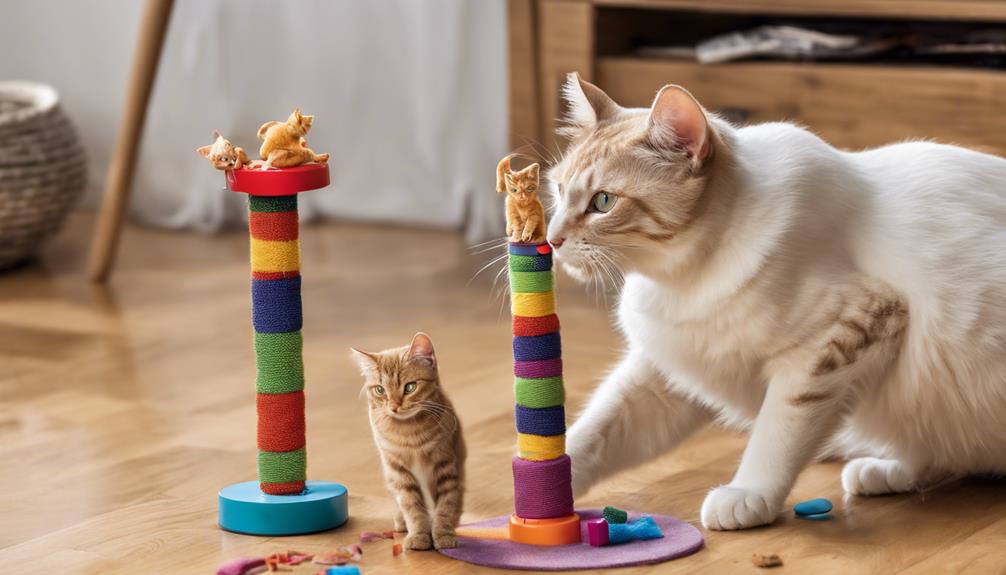
Engaging with interactive toys and creating an enriched environment are effective ways to prevent cat boredom and promote their well-being. To keep your feline friend mentally stimulated and happy, consider these tips:
- Interactive Toys: Providing puzzle feeders and toys that dispense treats can engage your cat's mind and prevent boredom.
- Regular Playtime: Engage in daily play sessions to prevent boredom and strengthen the bond between you and your cat.
- Enriched Environment: Set up climbing structures, scratching posts, and hiding spots to keep your cat mentally active and entertained.
- Establish Routine: Creating a consistent schedule for feeding, play, and interaction can help alleviate cat boredom by providing structure and predictability.
- Companion Cats: If possible, consider getting a companion cat for social interaction, especially for single cats who may benefit from feline companionship.
Keeping Cats Stimulated

To guarantee cats are stimulated, offering a variety of interactive toys and enriching their environment with climbing structures and hiding spots is crucial. If a cat is bored, it may display signs of restlessness, excessive grooming, or even destructive behavior.
To help prevent boredom, creating a stimulating environment for your cat is vital. Consider incorporating scratching posts, window perches, and puzzle feeders to engage their natural behaviors. Rotating toys regularly and engaging in interactive play sessions daily can also go a long way in keeping your feline friend entertained.
Indoor foraging experiences, such as hiding treats around the house, can stimulate their hunting instincts and provide mental enrichment. Remember, a happy and mentally stimulated cat is less likely to develop behavioral issues. By investing time and effort in enriching your cat's environment, you can ensure they lead a fulfilling and contented life.
Frequently Asked Questions
How Do I Know if My Cat Is Bored?
We notice our cat might be bored if they groom excessively, act destructively, vocalize more, lose interest in toys, or sleep excessively. Engaging in play, enriching their environment, and establishing routines can help.
How Do I Keep My Indoor Cat Entertained?
We keep our indoor cat entertained by providing interactive toys, climbing structures, varied playthings, window views, and even a companion cat for social interaction. Engaging these activities regularly prevents boredom and keeps our feline friend happy.
How Do I Stop My Indoor Cat From Getting Bored?
To prevent indoor cats from getting bored, we provide interactive toys, rotate them often, engage in play sessions, and create a stimulating environment with climbing structures and hiding spots. A companion cat can also offer social interaction.
Does My Cat Get Bored at Night?
Nights can leave cats restless. Engaging playtime and interactive toys before bedtime can keep them entertained. An enriched environment with climbing structures and toys can prevent boredom. Our feline friends need our attention.
Conclusion
To sum up, cats can indeed get bored, leading to various behavioral indicators. By understanding these signs and implementing strategies to prevent boredom, such as engaging playtime and keeping them stimulated, we can guarantee our feline friends lead happy and fulfilled lives.
Just like us, cats need mental and physical stimulation to thrive. So, let's make sure to keep our furry companions entertained and content, creating a purr-fect environment for them to thrive in.
